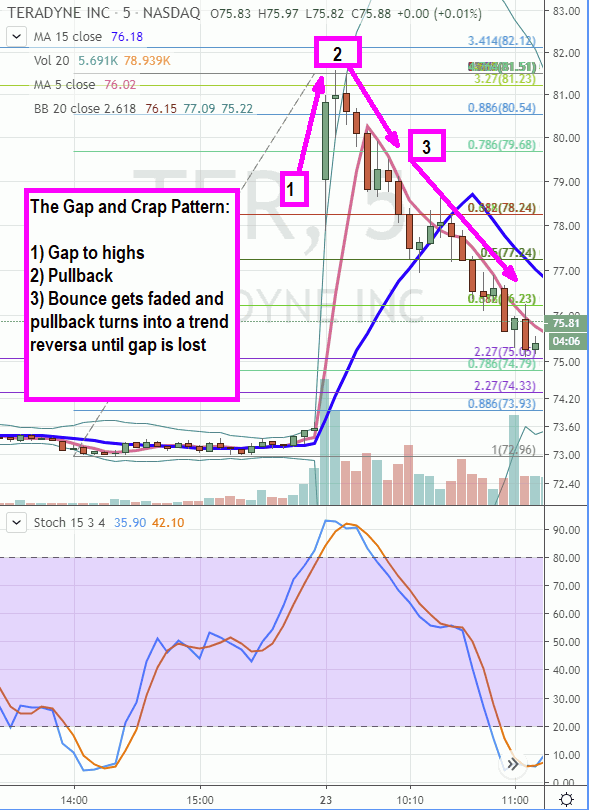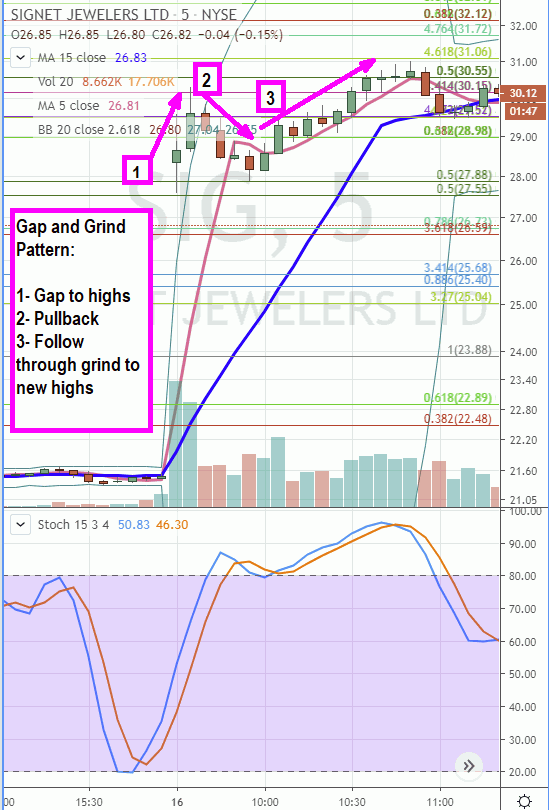Earnings season inevitably provides a plethora of stocks that react with gappers and dumpers. Gappers are stocks that gap up on results and dumpers are stocks that gap down on results. We will review the key gapper patterns that can be traded intraday. It’s important to remember to focus on the (price) reaction not the reason for the gap. Assuming you have created your earnings gapper watch list and assessed the full playing field of price inflection points pre-market, the next stage is to observe which of three potential patterns play out. Each of the patterns have distinct characteristics and tradeable set-ups. We will reference these as gap patterns, but they also apply to dumpers that gap down equally.
The Three Reactions Off the Market Open
Most gap patterns undergo three reactions on the open before the follow-through takes over. The first reaction is the spike to highs on the gap up off the open. The second reaction is the initial peak and pullback to support. The third reaction is the resumption of uptrend as shares grind to new intraday highs. The same applies inversely on gaps down. Each of the three reactions provides a trading opportunity for traders that have prepared price inflection points ahead of time.

The Gap and Crap Pattern
A gap and crap pattern occur when a stock gaps up and then proceeds to sell-off giving back most if not all the price gap. The same applies on stocks that gap down (dumpers) that bottom and proceeds to recover most if not all the losses from the initial gap down. The key component here is the reversal and follow through in the opposite direction of the gap. Usually, the second reaction reversion attempt tends to happen in the first five-to-20 minutes before the reversal fade forms the third reaction as the trend reversal follows through giving back the gap.

A gap and grind pattern occurs when a stock gaps up, forms a shallow pullback and then proceeds to grind higher to new highs. On dumper stocks, the stock gaps down, attempts to bounce but gets rejected and proceeds to continue to sell-off making new intraday lows. Usually, a reversion attempt tends to happen in the first five-to-15 minutes before the trend resumes in the direction of the gap.
The Third Reaction Determines the Pattern
The first two reactions are similar between the gap and crap and gap and grind, with the distinguishing factor being how the third reaction plays out. Both patterns hit a peak and then a reversion pullback. The third reaction is what distinguishes the difference. On a gap and crap, the third reaction is an attempt to bounce back up that gets faded, usually at the 5-period moving average (MA), which causes the stock to turn the pullback into a full-blown trend reversal. On a gap and grind, the third reaction is to bounce back through the 5-period MA to resume the trend in the direction of the gap and proceed to make new highs or lows in the case of a gap down. If the gapper stock is too pricey or too volatile, make sure you have sympathy laggard peer stock that you can trade using the gapper stock as a lead indicator.
Place Your Orders Ahead of Time
A good way to get prepared is to practice placing your bids to buy and asks to seller ahead of time. Of course, you can cancel these orders as price nears. The process of placing orders ahead of time forces you to be forward-thinking and automatically makes you be proactive and reactive. The advent of zero-commission trading also enables traders to scale into a position in tiny pieces at multiple price levels to improve the average price both into and out of positions. This is especially helpful for new stocks you’re trying to get acclimated too. Use smaller size positions so you can focus on the trade and not the profit and loss blotter. If you get chopped around too much, revert to a wider time frame trigger chart or switch to another gapper stock. It is important to also pace yourself properly during the trading day to capitalize during the period of heaviest momentum, liquidity, and volatility. More on this in upcoming articles.
Before you make your next trade, you'll want to hear this.
MarketBeat keeps track of Wall Street's top-rated and best performing research analysts and the stocks they recommend to their clients on a daily basis.
Our team has identified the five stocks that top analysts are quietly whispering to their clients to buy now before the broader market catches on... and none of the big name stocks were on the list.
They believe these five stocks are the five best companies for investors to buy now...
See The Five Stocks Here
MarketBeat's analysts have just released their top five short plays for July 2025. Learn which stocks have the most short interest and how to trade them. Enter your email address to see which companies made the list.
Get This Free Report
Like this article? Share it with a colleague.
Link copied to clipboard.